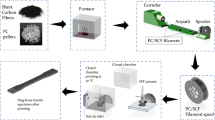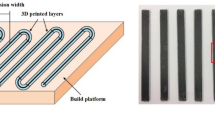AbstractQuery
The objective of this paper is to present the modeling approach for homogenizing the 3D-printed composite parts for the accurate prediction of effective mechanical properties. The Mori–Tanaka (MT) approach associated with two-step homogenization is applied to partially oriented short carbon fiber (SCF)-reinforced polycarbonate (SCF/PC)-based composites and compared with the experimental results. Detailed microstructural analysis was performed to investigate the variation in fiber length and bead dimensions that occurred due to change in fiber percentage (3%, 5%, 7.5%, and 10% by vol.). A two-step homogenization framework was performed in this research. Change in fiber length was considered in the first-step homogenization and change in bead dimensions was considered in the second step of homogenization approach to find the microscale and mesoscale constitutive properties of SCF/PC 3D-printed composite samples using the MT method respectively. Results of this study revealed that the stiffness of the composite samples increases with the increase in fiber percentage. As we increase the SCF, significant variations were observed in the fiber length and bead dimensions which also significantly affect the mechanical properties of 3D-printed composite parts. Results obtained after considering the fiber length and bead dimensions in mathematical calculation helps in reducing the error gap between the homogenized numerical and experimental results. It was also concluded that the prediction of Young’s modulus using higher fiber percentage has relatively low errors. Eventually, the properties attained from the respective approach help to find out the macro fields (average stress and average strain) in the 3D-printed composite samples.
Graphical abstract





















Similar content being viewed by others
References
Kruth JP, Mercelis P, Van Vaerenbergh J, et al (2005) Binding mechanisms in selective laser sintering and selective laser melting. Rapid Prototyp. J.
Melchels FPW, Feijen J, Grijpma DW (2010) A review on stereolithography and its applications in biomedical engineering. Biomaterials 31:6121–6130
Ahn SH, Montero M, Odell D et al (2002) Anisotropic material properties of fused deposition modeling ABS. Rapid Prototyp J. https://doi.org/10.1108/13552540210441166
Jiang J, Lou J, Hu G (2019) Effect of support on printed properties in fused deposition modelling processes. Virtual Phys Prototyp. https://doi.org/10.1080/17452759.2019.1568835
Jiang J, Xiong Y, Zhang Z, Rosen DW (2020) Machine learning integrated design for additive manufacturing. J Intell Manuf. https://doi.org/10.1007/s10845-020-01715-6
Klosterman D, Chartoff R, Graves G et al (1998) Interfacial characteristics of composites fabricated by laminated object manufacturing. Compos Part A Appl Sci Manuf. https://doi.org/10.1016/S1359-835X(98)00088-8
Fidan I, Imeri A, Gupta A et al (2019) The trends and challenges of fiber reinforced additive manufacturing. Int J Adv Manuf Technol. https://doi.org/10.1007/s00170-018-03269-7
Mallick PK (2007) Fiber-reinforced composites: materials, manufacturing, and design, third edition
Mohammadizadeh M, Gupta A, Fidan I (2021) Mechanical benchmarking of additively manufactured continuous and short carbon fiber reinforced nylon. J Compos Mater. https://doi.org/10.1177/00219983211020070
Fidan I, Imeri A, Gupta A, et al (2019) The trends and challenges of fiber reinforced additive manufacturing. Int J Adv Manuf Technol 102. https://doi.org/10.1007/s00170-018-03269-7
Gupta A, Fidan I, Hasanov S, Nasirov A (2020) Processing, mechanical characterization, and micrography of 3D-printed short carbon fiber reinforced polycarbonate polymer matrix composite material. Int J Adv Manuf Technol 1–21. https://doi.org/10.1007/s00170-020-05195-z
Gupta A, Hasanov S, Fidan I (2019) Processing and characterization of 3d-printed polymer matrix composites reinforced with discontinuous fibers. In: Proceedings of the 30th Annual International Solid Freeform Fabrication Symposium – An Additive Manufacturing Conference. pp 1054–1066
Hasanov S, Gupta A, Nasirov A, Fidan I (2020) Mechanical characterization of functionally graded materials produced by the fused filament fabrication process. J Manuf Process 58:923–935. https://doi.org/10.1016/j.jmapro.2020.09.011
Nemat-Nasser S, Hori M (1999) Micromechanics : overall properties of heterogeneous materials (2^{\textrm{nd}}, revised. North-Holland, Amsterdam, The Netherlands
Hasanov S, Gupta A, Alifui-segbaya F, et al Experimental characterization and numerical homogenization of the fiber reinforced functionally graded composites fabricated by the fused filament fabrication process
Yan CK (2003) On homogenization and de-homogenization of composite materials. Drexel University, Ann Arbor
Yang QS, Tao X, Yang H (2007) A stepping scheme for predicting effective properties of the multi-inclusion composites. Int J Eng Sci. https://doi.org/10.1016/j.ijengsci.2007.07.005
(1957) The determination of the elastic field of an ellipsoidal inclusion, and related problems. Proc R Soc London Ser A Math Phys Sci. https://doi.org/10.1098/rspa.1957.0133
Mori T, Tanaka K (1973) Average stress in matrix and average elastic energy of materials with misfitting inclusions. Acta Metall. https://doi.org/10.1016/0001-6160(73)90064-3
Weng GJ (1984) Some elastic properties of reinforced solids, with special reference to isotropic ones containing spherical inclusions. Int J Eng Sci. https://doi.org/10.1016/0020-7225(84)90033-8
Benveniste Y (1987) A new approach to the application of Mori-Tanaka’s theory in composite materials. Mech Mater. https://doi.org/10.1016/0167-6636(87)90005-6
Norris AN (1985) A differential scheme for the effective moduli of composites. Mech Mater. https://doi.org/10.1016/0167-6636(85)90002-X
Christensen RM, Lo KH (1979) Solutions for effective shear properties in three phase sphere and cylinder models. J Mech Phys Solids. https://doi.org/10.1016/0022-5096(79)90032-2
Hill R (1963) Elastic properties of reinforced solids: some theoretical principles. J Mech Phys Solids. https://doi.org/10.1016/0022-5096(63)90036-X
Hill R (1965) A self-consistent mechanics of composite materials. J Mech Phys Solids. https://doi.org/10.1016/0022-5096(65)90010-4
Budiansky B (1965) On the elastic moduli of some heterogeneous materials. J Mech Phys Solids. https://doi.org/10.1016/0022-5096(65)90011-6
Taya, Minoru and T-WC (1981) On two kinds of ellipsoidal inhomogeneities in an infinite elastic body: an application to a hybrid composite. 17.6 (1981): 553–563. Int J Solids Struct 17:553–563. https://doi.org/10.1016/0020-7683(81)90018-4
Li LX, Wang TJ (2005) A unified approach to predict overall properties of composite materials. Mater Charact. https://doi.org/10.1016/j.matchar.2004.10.005
Torquato S (1998) Effective stiffness tensor of composite media: II. Applications to isotropic dispersions. J Mech Phys Solids. https://doi.org/10.1016/S0022-5096(97)00083-5
Tandon GP, Weng GJ (1984) The effect of aspect ratio of inclusions on the elastic properties of unidirectionally aligned composites. Polym Compos. https://doi.org/10.1002/pc.750050413
Huang H, Talreja R (2005) Effects of void geometry on elastic properties of unidirectional fiber reinforced composites. Compos Sci Technol. https://doi.org/10.1016/j.compscitech.2005.02.019
Hasanov S (2021) Numerical modeling and experimental characterization of functionally graded materials manufactured by the fused filament fabrication process
Nasirov A (2019) Multiscale modeling of fused filament fabricated specimens. Tennessee Technological University
Nasirov A, Gupta A, Hasanov S, Fidan I (2020) Three-scale asymptotic homogenization of short fiber reinforced additively manufactured polymer composites. Compos Part B Eng 202:108269. https://doi.org/10.1016/j.compositesb.2020.108269
Nasirov A, Hasanov S, Nasirov A, et al Prediction of mechanical properties of fused deposition modeling made parts using multiscale modeling and classical laminate theory 3D printing of medical devices view project fiber reinforced additive manufacturing view project prediction of mechanical properties of fused deposition modeling made parts using multiscale modeling and classical laminate theory
Hasanov S, Gupta A, Alifui-Segbaya F, Fidan I (2021) Hierarchical homogenization and experimental evaluation of functionally graded materials manufactured by the fused filament fabrication process. Compos Struct 275. https://doi.org/10.1016/j.compstruct.2021.114488
Mura T (2013) Micromechanics of defects in solids. Martinus Nijhoff Publishers
Hashin Z (1983) Analysis of composite materials: a survey. J Appl Mech Trans ASME DOI 10(1115/1):3167081
Miehe C, AK, (2002) Computational micro-to-macro transitions of discretized microstructures undergoing small strains. Arch Appl Mech 72:300–317. https://doi.org/10.1007/s00419-002-0212-2
Yang QS, Becker W (2004) A comparative investigation of different homogenization methods for prediction of the macroscopic properties of composites. C - Comput Model Eng Sci. https://doi.org/10.3970/cmes.2004.006.319
Weinberger, Chris, Wei Cai and DB (2005) Lecture notes–elasticity of microscopic structures. Stanford University
Forster AM (2015) Materials testing standards for additive manufacturing of polymer materials: state of the art and standards applicability. In: Additive Manufacturing Materials: Standards, Testing and Applicability
Jin X, Keer LM, Wang Q (2011) A closed-form solution for the Eshelby tensor and the elastic field outside an elliptic cylindrical inclusion. J Appl Mech Trans ASME DOI 10(1115/1):4003238
Acknowledgements
The technical support provided by the Center for Manufacturing Research (CMR) is greatly appreciated.
Funding
The authors received financial support from the Center for Manufacturing Research (CMR).
Author information
Authors and Affiliations
Contributions
Ankit Gupta conceived the presented idea (homogenized modeling approach for effective property prediction of 3D-printed short fibers reinforced polymer matrix composite materials), developed the theory, performed the experimentations and computations, and wrote the manuscript with support from Seymur Hasanov, Dr. Ismail Fidan, and Zhicheng Zhang. Seymur Hasanov and Dr. Ismail Fidan encouraged Ankit Gupta to investigate more in terms of homogenized modeling by performing detailed microstructural analysis. Dr. Ismail Fidan supervised the findings of this work. All authors discussed the results and contributed to the final manuscript.
Corresponding author
Ethics declarations
Ethics approval
This research is based on the PhD research work of Mr. Ankit Gupta. Submission of this paper is approved by him.
Consent to participate
The researchers have informed consents from all participants.
Consent for publication
All authors and participants gave their consent to publish.
Competing interests
The authors declare no competing interests.
Additional information
Publisher’s note
Springer Nature remains neutral with regard to jurisdictional claims in published maps and institutional affiliations.
This paper is from our original research work; the work described has not been published before; it is not under consideration for publication anywhere else; and its publication has been approved by all co-authors.
Appendix
Appendix
This section shows the Eshelby’s S tensors used in this study [43]. The local coordinate system used in this study may not match with the global coordinate system used in other computations.
For fiber-like inclusions
Elliptic cylinder with c goes to infinity
Rights and permissions
About this article
Cite this article
Gupta, A., Hasanov, S., Fidan, I. et al. Homogenized modeling approach for effective property prediction of 3D-printed short fibers reinforced polymer matrix composite material. Int J Adv Manuf Technol 118, 4161–4178 (2022). https://doi.org/10.1007/s00170-021-08230-9
Received:
Accepted:
Published:
Issue Date:
DOI: https://doi.org/10.1007/s00170-021-08230-9




